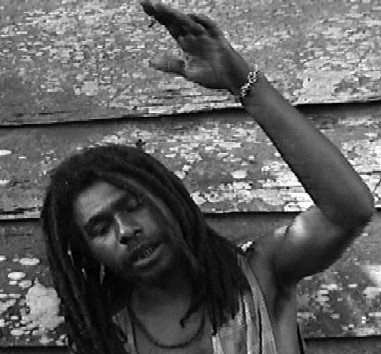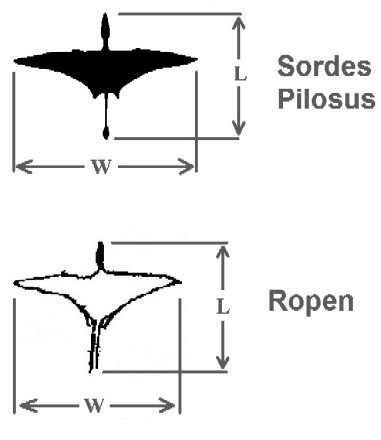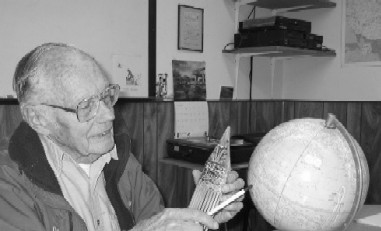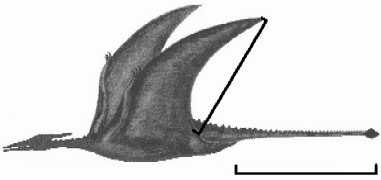Ropen: Flying Reptiles Alive Today
Posted by: Loren Coleman on July 21st, 2006
One of the routine ways of looking at reports of giant flying creatures from exotic lands is as shown in the new comic, Cryptid, as giant bats (below). But there is another school of thought too.

In Africa, they are called Kongomato (see below – William M. Rebsamen art from Cryptozoology A to Z and a mysterious photograph of one that has surfaced on the internet). In New Guinea, they are named Ropen. Some would have us consider if there are pterosaurs among us still today.

A new book, Searching for Ropens, proposes they do exist.
American cryptozoologist Matt Bille, author of Rumors of Existence and Shadows of Existence, told Cryptomundo, that unless the press release (below) is underselling the new evidence, the one concern Bille has is that Ropen researcher Jonathan Whitcomb "seems to be basing a lot on a few sightings."
Cryptomundo will review the book, if received (Loren Coleman, PO Box 360, Portland, ME 04112), but until then, here’s the latest just released on this new book.
Pterosaur-like Creatures Reported in Papua New Guinea
[Source: Based on a press release from PRWEB]
Intermittent expeditions on Umboi Island, Papua New Guinea, from 1994 through 2004, resulted in the compilation of eyewitness testimonies that substantiated a hypothesis that pterosaurs may not be extinct.
Long Beach, Calif.: July 21, 2006 — The investigation of reports of a pterosaur-like creature in Papua New Guinea has produced some promising findings. According to standard models of science, all pterosaurs became extinct by about 65-million years ago. But due to research of Jonathan Whitcomb, a forensic videographer who interviewed native islanders in 2004, the cryptid the natives call ropen of Umboi Island is at least similar to a long-tailed pterosaur.

He maintains that earlier researchers who explored the island intermittently from 1994 through 2002 were not overly imaginative in believing the creature to be a pterosaur. According to Whitcomb’s new book, Searching for Ropens, there are many similarities between American, Australian, and native eyewitness accounts. Ropens appear featherless with long tails, and reports indicate they eat fish.
Click image for full-size version
Whitcomb, from Long Beach, California, disputes an old idea that they are misidentifications of Flying Fox fruit bats. Two natives described a Ropen holding itself upright on a tree trunk (fruit bats hang upside down from branches), and his book also describes an apparently bioluminescent glow that may help the nocturnal creatures catch fish.
The puzzle for the previous investigators is that they’re unlike Rhamphorhynchoid pterosaur fossils in some ways: A few Ropens are too large and have dorsal ridges along the back. In addition, some eyewitnesses report a head crest on the Ropen while few long-tailed pterosaur fossils have such appendages.

Although Whitcomb admits having no photograph to disprove textbook declarations that all pterosaurs are extinct, he disputes the idea that the Ropen is an unknown bat. His book, Searching for Ropens, examines an investigation by the explorers Garth Guessman, a Southern California firefighter; and David Woetzel, a New Hampshire businessman. Their 2004 expedition, a few weeks after Whitcomb’s, uncovered a native tradition about the Ropen’s tail: It moves only near the tail’s base. This, says Guessman, relates to Rhamphorhynchoid pterosaur anatomy.

Duane Hodgkinson
Before his expedition to Papua New Guinea, Whitcomb questioned Duane Hodgkinson, a flight instructor in Livingston, Montana, who maintains he saw a large “pterodactyl” in 1944, near Finschhafen. The World War II veteran’s description resembles that given by a couple who saw a creature flying over Perth, Australia, in 1997.
Whitcomb also noted in Searching for Ropens similarities to native accounts recorded by earlier explorers on Umboi Island between 1994 and 2002. Whitcomb found no indication of any hallucination or hoax with the two Australians and the American veteran. He also noted that the native eyewitnesses he interviewed mentioned no supernatural elements and that their descriptions resemble those given by the Westerners.
Click image for full-size version
Around Manus Island, the wingspan is three to four feet, according to Jim Blume, a missionary in Wau, on the mainland. Blume’s investigations indicate that wingspans may reach ten to fifteen feet in other areas. Whitcomb’s book mentions a few Ropens that are even larger, including the ones seen by Hodgkinson and the Australian couple.
The book acknowledges differences between the Ropen and Rhamphorhynchoid fossils but it emphasizes that the “diamond” on the Ropen’s tail may relate to the fossil tails.
Whitcomb, a 57-year-old independent videographer who records evidence for attorney firms, completed his book after one year of compiling and analyzing eyewitness testimonies. He encourages a major expedition to videotape a Ropen before the end of 2007.
#####
Thanks to Matt Bille for bringing this release to our attention.

About Loren Coleman
Loren Coleman is one of the world’s leading cryptozoologists, some say “the” leading living cryptozoologist. Certainly, he is acknowledged as the current living American researcher and writer who has most popularized cryptozoology in the late 20th and early 21st centuries.
Starting his fieldwork and investigations in 1960, after traveling and trekking extensively in pursuit of cryptozoological mysteries, Coleman began writing to share his experiences in 1969. An honorary member of Ivan T. Sanderson’s Society for the Investigation of the Unexplained in the 1970s, Coleman has been bestowed with similar honorary memberships of the North Idaho College Cryptozoology Club in 1983, and in subsequent years, that of the British Columbia Scientific Cryptozoology Club, CryptoSafari International, and other international organizations. He was also a Life Member and Benefactor of the International Society of Cryptozoology (now-defunct).
Loren Coleman’s daily blog, as a member of the Cryptomundo Team, served as an ongoing avenue of communication for the ever-growing body of cryptozoo news from 2005 through 2013. He returned as an infrequent contributor beginning Halloween week of 2015.
Coleman is the founder in 2003, and current director of the International Cryptozoology Museum in Portland, Maine.












I know that fish-eating bats use highly developed echo-location to find fish while skimming over the water. However most fish-eating birds have highly-developed eyesite. I wonder what mechanisms a pterosaur would use to hunt.
I find this part of the argument interesting:
“The puzzle for the previous investigators is that they’re unlike Rhamphorhynchoid pterosaur fossils in some ways: A few Ropens are too large and have dorsal ridges along the back. In addition, some eyewitnesses report a head crest on the Ropen while few long-tailed pterosaur fossils have such appendages.”
This is phrased as if one should expect a creature – whose species has survived for 65 million years – would experience no evolutionary changes. I find this article fascinating, but this point of logic seems a bit off to me. But perhaps I am reading into things too much….
Loren,
I much appreciate the credit.
The whole business reminds me of Ivan Sanderson’s book mentioning reports of giant bats from the same region. While the tail obviously does not fit with a bat, two kinds of giant flying creatures from the same region seems highly unlikely, and it strikes me as more logical that there is only one creature, and some reports are in error.
Of course, Mysteriousness, you’re absolutely correct… these aren’t pterosaurs, they would be pterosaur descendants. There will be marked changes between the fossils and the living creatures, if found.
Good call on there being differences between any Pterosaur fossils and a possible living creature. That’s one of the biggest problems in dealing with unidentified creatures such as the Loch Ness creature, Bigfoot, and other assorted oddities. Scientists are always trying to compare them to fossils and the such, rarely seeming to consider that change is constantly occuring in nature despite what humanity thinks.
The Lost World, anyone? Reminds me of sightings some friends had back in the early 1960s off the Samoan Islands.
Hairless and featherless, grey to almost slightly pinkish in skin colour, a ‘flock’ of these 20-foot+ wingspanned ‘birds’ came in high over their sailing vessel around the same time each evening for several days.
My friends had earlier lost their masts in a fierce storm and ended up floating rudderless without food or water for 68 days before their eventual rescue.
These screaming furies would circle lower and lower and then make strafing runs low over the hull of their vessel. My friends had to retreat with their children into the cabin for protection when these frightening squadrons came over. They called them pterodactyls, for lack of any better term. And they really didn’t like talking about or retelling this truly weird experience. It was all too baffling and unnerving.
This is a subject I’m very interested in. I grew up on a reservation hearing the stories of the “Thunderbirds”, and when I asked what they looked like I was always told that they were unlike the birds we see now. They were hairless
and ate sheep, dogs, calves etc. As an adult I traveled to Guatemala, Peru and all over the South Americas. I found a lot of reference’s and artwork depicting Pterosaurs. If you look in the Americas you will find that the pyasol Indians had a legend, with cave drawings of a giant pterodactyl(?) that used to actively hunt the humans and eat them. I think that as we continue to destroy habitat it is only a matter of time until these creatures will be forced out into the open and then their existence won’t be debated, it will be, how do we save them?
Well, the coelacanth haven’t changed in 60 million years…
Matt Bille, do you know of any recent sightings/expeditions regarding the ahool – a similar pterosaur-like creature on the Java Island?
This reminds me of the time I saw a gigantic bird while I was on vacation in Hawaii. Are there any reports of thunderbirds or any kind of peculiar avians from that region?
I believe Plato wrote about strange flying lizards that were native to Egypt during his time. He also wrote that they were venomous! I know it’s not New Guinea but another interesting story all the same. Could possibly be related to the Kongomato though. (by the way that’s a fascinating photo Loren!)
There is also the possibility that these cryptids are animals for which there is little or no fossil evidence. (Or there is fossil evidence, but it is misidentified or misinterpreted.) Not everything gets fossilized, found, correctly reconstructed, and correctly classified.
Take gigantopithecus, for example. From what I understand the only fossil evidence for them are teeth and some jaw fragments – everything else we are supposed to “know” about them are extrapolations, speculations, assumptions, etc. made from this very limited physical evidence.
The photo looks very strange does anyone know the story behind it. Where it was taken or proved valid or hoax????
I agree with twblack. Something about the photo just doesn’t seem right.
I don’t know of any investigations of the ahool since Ivan Sanderson wrote about it in “Investigatign the Unexplained.” Anyone else?
Matt
Very interesting article. Thanks for posting Loren! I’d love to have more information on that photograph too if anyone has any. I remember reading about these creatures or something similar in Jerome Clark’s book “Unexplained!”
I just got the book today and it is hard to put down. It is well written and reading about the authors motivation, inspiration and ultimately the courage to undertake the adventure, is as fascinating as the ropen itself. I can see some people probably being put off by the authors personal beliefs (not me) but I am about half way through, and like I said, it is hard to put down.
Sounds like Papua/New Guinea will be places of many species discoveries in the near future (if explorers can get access).
Would make a good destination for finding both pterosaurs/descendants and also thylacines! 🙂
There is no reason that all dinos had to die out. That was one thing none of my biology teachers could tell me, how did they evolve into birds if they died out before any actual bird was suppose to come one the scene? I hope one of these get “found”, I would love to hear the “experts” on evolution explain this one. Wasn’t there suppose to be something like this in Poteete, Texas? Of course that would probably be more a pterodactyl, right? I do believe it’s within a short drive from Poteete to the discovery site of pterodactyl fossils. There was even suppose to be actual news footage or something like that. I’m sorry to say this, seeing how much I really want this to be true, but the pic of that flying thing, it looks like a high tech airplane. Do we know when that pic was taken? It’s color, so that would make it within the last 40 to 50 years, depending on who took it.
I remember seeing ether Chinese or Japanese art that dipicted these creatures. The art work was fairly old. I don’t remember a date but it had people scatching there head. Also, I wonder if this could contribute to any dragon myths the asian people have?
One more thing, on the subject of dinosaurs being extinct for 65 million years… I have read on MSNBC before (I wish to high heaven I remembered the name of the article!) a paleontologist talk about how he had seen many dinosaur bones before that looked like they were only a few hundred years old. But he “knew” they couldn’t be and so dated them at the ‘correct’ age of 65+ million years…
“how did they evolve into birds if they died out before any actual bird was suppose to come one the scene?”
What are you talking about? Birds appear before the extinction of the dinosaurs…
Found it –
2003-New Hampshire. November 6-On the 25th of October in Plymouth, Joy P. was in the middle of a train trip. While observing the landscape, she decided to take photographs of the passing scenery. One of her pictures of red deer in a forest would show a strange, flying craft of a trianglar shape. According to the Joy’s statement on the North American website Coast to Coast, when making the series of photographies, she never observed anything out of the ordinary while taking the landscape pictures.
Editor: Please see “Mystery Flying Cryptid Photo” for further discussion of this photograph. Thank you.
In regards to the reputed Ropens head crest, Austriadactylus was a rhamphorhynchoid pterosaur from the Upper Triassic that did have a crest on it’s head. That one was found in Austria, not Australasia. Still, it’s worth noting that there is a surviving reptile from about that same time period still hanging on in New Zealand, the tuatara. How did they become the last living member of a 200 million year old family, the Order Sphenodontia? New Guinea apparently had until recently it’s own reptile survivor, the fearsome giant monitor Megalania. Although not as ancient as the tuatara both the Megalania and it’s Komodo Dragon cousins managed to hang on for a very long time in that general part of the world.
Hunting for the Ropens: It would be fun to send up one of those mechanical pterosaurs the Stanford Pterosaur Replica Project created with the National Geographic Society, armed with cameras in that part of New Guinea.
I know, dream on!
P.S. I am aware that the head crest on the Austriadactylus cristatus isn’t the same as in the Ropens drawing but still thought it was worth pointing out.
Great job in writing this story Loren.The photo is very intresting great picture it does show apicture of an unknown huge bird.Great comments on this subject.In my opinion it does look like a Pterosaur.Wish i hope itis probably not.The only way you prove its existence once again take acloser photograph or some how capture one.
I am wary of claims of pterodactyls, if only for the many occasions I have witnessed where people see herons and claim pterodactyl. I conduct field trips in the local salt marsh, and although I deal primarily with school groups, most of the people who have said this have been the adults, not the kids. I believe herons to be responsible for several Jersey Devil reports as well. These people misinterpret the long legs for a tail and the curled neck for a head crest.
That having been said, pterosaurs are at least a more plausible survivor of the Xiculub impact than the really big beasties. After all, birds DID survive, as did the sizeable alligators, crocodiles, and varanids (Although perhaps it was only the smaller species that survived, eventually branching off into larger forms again once the environment healed itself). Pterosaurs are small, and of course we would expect to find adaptation and speciation to have continued over the past 65 million years.
On the other hand, we could just as easily have an incidence of parallel evolution. Pterodactyls were very successful, and nature uses (and re-uses) the tricks that work. I actually think it would be MORE interesting if we discovered not an existing pterosaur, but something completely new that evolved similar anatomical features.
As for the photo- so now we have blobdactyls too?
Again, it was originally a UFO photo, it was never supposed to be a photo of a Ropen.
“UFO” means “unidentified flying object.” There is no direct connection between the object photographed and it being a known craft from outer space. It could be cryptozoological in origin.
Please see “Mystery Flying Cryptid Photo” for further discussion of this photograph. Thank you.
What this always comes down to, like my dad always tells me if me and him have discussions about cryptozoology. My dad says show me a good clear convincing photo then maybe he will believe it. This photo here is kind of hard to describe. It’s great that everybody has a different opinion on what it might be?
I read about living Dinosaurs. The ropen might a Pteranodon longiceps or a Quetzalcoatlus.
It’s interesting that people always try to correlate sightings of mysterious creatures with known fossils. The animals known from fossils are just the tip of the iceberg. For the vast majority of species, no fossils have yet been found. So the chance of a living creature belonging to any known fossil species is slim. That being said, there are many animals that have survived, apparently little-changed, from remote prehistoric times. Ahools or ropens could be pterosaurs or giant bats. I think giant bats are more likely than pterosaurs, for the simple reason that there is a whole range of bat sizes and species, some very common, but no one has seen flocks and roosts of small pterosaurs. The probability of a giant species surviving, where smaller ones has failed, seems unlikely.
It looks like the pictures in this video.
maybe i’m just as blind as a giant gorilla-faced bat here…but it looks like an airborne manta ray to me.
bet you didn’t know THOSE existed, did you?
…
well, they don’t. but it would be cool if they did.
I have a photo of a Ropen my friends shot and killed in Mexico. I assure you it is 100 % real. Unfortunately I cannot release the photo and the whereabouts of the corpse is unknown.
It’s just a bird is your belief?
Well hold up a second Chief,
I’ll make my rebuttal brief,
Don’t you know birdies don’t have teeth?